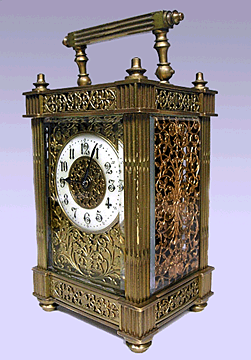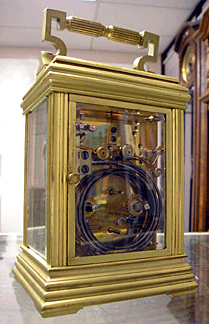 A
carriage clock is a distinctive French-made portable,
spring-driven timepiece using a platform escapement. Produced in
large numbers mostly from the 1850's through the early 1920's, a
few are still made today. The case is most commonly a rectangular,
box-like shape made of brass and sometimes gilded, with four
corner pillars, with glass, brass, or porcelain sides. The front
and back are often hinged to allow access for the operator with a
handle built into the top to assist in carrying, and perhaps a
wooden outer-fitted box for protection during travel, often with a
viewing window at the top showing the balance escapement. The
enamel dials are white with plain black numerals for better
low-light viewing, often stamped with the retailers’ name which
may rub off if touched. These clocks often had additional features
such as a strike, alarm, a calendar, and even a thermometer.
Further compilations would have included a repeating mechanism
with the grande sonnerie being the top of the line. The
case can be rather plain or highly decorated with beveled glass
panels, pierced brass, enamel fillings, cloisonné or other
embellishments. Sometimes, these clocks come in an oval shape. A
carriage clock is a distinctive French-made portable,
spring-driven timepiece using a platform escapement. Produced in
large numbers mostly from the 1850's through the early 1920's, a
few are still made today. The case is most commonly a rectangular,
box-like shape made of brass and sometimes gilded, with four
corner pillars, with glass, brass, or porcelain sides. The front
and back are often hinged to allow access for the operator with a
handle built into the top to assist in carrying, and perhaps a
wooden outer-fitted box for protection during travel, often with a
viewing window at the top showing the balance escapement. The
enamel dials are white with plain black numerals for better
low-light viewing, often stamped with the retailers’ name which
may rub off if touched. These clocks often had additional features
such as a strike, alarm, a calendar, and even a thermometer.
Further compilations would have included a repeating mechanism
with the grande sonnerie being the top of the line. The
case can be rather plain or highly decorated with beveled glass
panels, pierced brass, enamel fillings, cloisonné or other
embellishments. Sometimes, these clocks come in an oval shape.
These clocks were
never intended for use on a carriage as the English name suggests.
Don’t trust the carrying handle as they have been known to
break.
Regulation
Carriage clocks use a platform escapement, similar to a balance
wheel in a mechanical watch. Look for the metal regulating whip,
its "tail" is near the top of the clock. It should be
in-between a faster and slower declination, normally marked with
an "F" and "S" for faster slower or
"A" and "R" for advance or retard. Move the
whip toward the letter you want the clock to be adjusted by, for
instance moving toward the "F" or "A" makes
the clock faster, toward the "S" or "R" for
slower. Regulation should be done daily till the timekeeping is
close enough that a minor resetting is necessary when you perform
the weekly winding.
 Repeating Strike Repeating Strike
The time can be recalled by means of a pushbutton. This allowed
one to get the time in the dead of night without having to fumble
around for a candle. An hour repeater
only repeats the
last-passed hour, a quarter repeater will repeat the last-passed
hour and quarter and a minute repeater can strike out the time to
the last hour, quarter, and minute passed.
Setting the time
Usually the key for these clocks has two ends. The large side is
for winding and the smaller one is used to engage the hand setting
arbor. Look carefully for a directional arrow to indicate which
way to turn the hands. IN MOST CASES SETTING A CLOCK OF THIS TYPE
COUNTER-CLOCK WISE WILL DAMAGE THE "FIRING MECHANISM"
FOR THE STRIKE. Set slowly and smoothly. If you feel a binding in
the setting operation, do not use force.
Winding
Most clocks of this type run for seven days. Clocks that tell time
only will have one winding arbor. If the clock has a strike
or alarm feature, there will be additional winding arbors. Be sure
not to mistake the hand setting shaft for a winding arbor.
< Back
to Clocks Page
Go to Clock Care Tips > |
